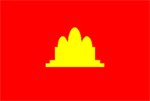 Khmer Rouge seized power in 1975, and in 1976 Khmer Rouge established a new constitution with the new flag under offical name, Democratic Kampuchea Khmer Rouge means Red Khmer translated from French and it was named by former King and Prime Minister Norodom Sihanouk. As one of the most violent regimes of the 20th century, the Khmer Rouge regime was responsible for the deaths of approximately 1.7 million people by execution, starvation and forced labor.
Khmer Rouge seized power in 1975, and in 1976 Khmer Rouge established a new constitution with the new flag under offical name, Democratic Kampuchea Khmer Rouge means Red Khmer translated from French and it was named by former King and Prime Minister Norodom Sihanouk. As one of the most violent regimes of the 20th century, the Khmer Rouge regime was responsible for the deaths of approximately 1.7 million people by execution, starvation and forced labor.
Known Name of Khmer Rouge:
• Khmer Rouge
• Democratic Kampuchea
• Pol Pot Regime
• Genocide Regime
• Killing Fields
• Cambodian Communists
• Red Khmer
• Communist Party of Cambodia
• Cambodian Genocide
• Khmer Krah-Ham (in Khmer, means Red Khmer)
• Angkar (in Khmer, means Government)
Brief Background of Khmer Rouge:

The Khmer Rouge, organized by Pol Pot in the Cambodian jungle in the 1960s, advocated a radical Communist revolution that would wipe out Western influences in Cambodia and set up a solely agrarian society. In 1970, aided by North Vietnamese and Viet Cong troops, Khmer Rouge guerrillas began a large-scale insurgency against Cambodian government forces, soon gaining control of nearly a third of the country.
By 1973, secret U.S. bombings of Cambodian territory controlled by the Vietnamese Communists forced the Vietnamese out of the country, creating a power vacuum that was soon filled by Pol Pot's rapidly growing Khmer Rouge movement. In April 1975, the Khmer Rouge captured Phnom Penh, the Cambodian capital, overthrew the pro-U.S. regime, and established a new government, the Kampuchean People's Republic.
As the new ruler of Cambodia, Pol Pot set about transforming the country into his vision of an agrarian utopia. The cities were evacuated, factories and schools were closed, and currency and private property was abolished. Anyone believed to be an intellectual, such as someone who spoke a foreign language, was immediately killed. Skilled workers were also killed, in addition to anyone caught in possession of eyeglasses, a wristwatch, or any other modern technology. In forced marches punctuated with atrocities from the Khmer Rouge, the millions who failed to escape Cambodia were herded onto rural collective farms.
Between 1975 and 1978, an estimated two million Cambodians died by execution, forced labor, and famine. In 1978, Vietnamese troops invaded Cambodia, capturing Phnom Penh in early 1979. A moderate Communist government was established, and Pol Pot and the Khmer Rouge retreated back into the jungle.
In 1985, Pol Pot officially retired but remained the effective head of the Khmer Rouge, which continued its guerrilla actions against the government in Phnom Penh. In 1997, however, he was put on trial by the organization after an internal power struggle ousted him from his leadership position. Sentenced to life imprisonment by a "people's tribunal," which critics derided as a show trial, Pol Pot later declared in an interview, "My conscience is clear." Much of the international community hoped that his captors would extradite him to stand trial for his crimes against humanity, but he died of apparently natural causes while under house arrest in 1998.

Cambodian Meo Soknen, 13, stands inside a small shrine full of human bones and skulls, all victims of the Khmer Rouge, near her home in the Kandal Steung district of Kandal province, Cambodia.
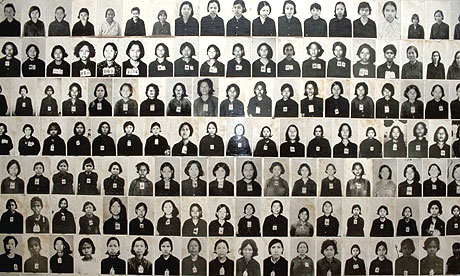
Images of genocide victims are displayed on the walls of the Tuol Sleng Musuem of Genocidal Crime, formerly the Khmer Rouge torture centre run by Kaing Guek Eav. Photograph: Corbis

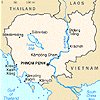
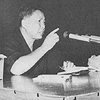
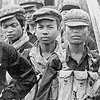
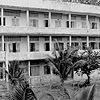



 people — nearly one-quarter of Cambodia’s population — were dead from execution, disease, starvation and overwork, according to the Documentation Center of Cambodia.
people — nearly one-quarter of Cambodia’s population — were dead from execution, disease, starvation and overwork, according to the Documentation Center of Cambodia. Vann Nath, one of the few survivors of the prison run by Duch, told The Phnom Penh Post last month. Even though Duch was not a senior leader with the movement, many Cambodians were relieved that one of the regime’s former leaders was facing justice, said Youk Chhang, head of the Documentation Center of Cambodia.
Vann Nath, one of the few survivors of the prison run by Duch, told The Phnom Penh Post last month. Even though Duch was not a senior leader with the movement, many Cambodians were relieved that one of the regime’s former leaders was facing justice, said Youk Chhang, head of the Documentation Center of Cambodia.